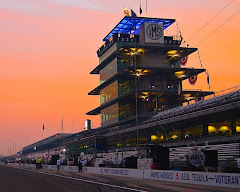"The author claims that the attendance estimate for Edmonton (a strong
60,000 on race day) is equivalent to the estimates for Kansas, Kentucky and
Chicagoland." - The Wicker Bill
Constructive debate becomes impossible when the counterparty engages in gross mischaracterizations. Let's review what I actually wrote.
"Attendance at IndyCar oval races at Kansas, Kentucky and Chicagoland was
undeniably awful in 2009." - Roggespierre
Any assertion that attendance at these races was equal to that of Edmonton, St. Pete and Mid-Ohio would obviously be inacurrate. That is why I wrote nothing of the sort.
I did in fact write that attendance at these events was approximately 60,000 back when the IndyCar Series was a predominantly oval racing product. It is now a predominantly road racing product. Its roster of drivers includes exactly one full-time entry that is driven by an oval racer, and he happens to be the founder's stepson. That is not much of a value proposition for U.S. spectators, a vast majority of whom has demonstrated that it prefers oval racing products.
I also articulated my moral abhorrence of publicly subsidized racing events. Edmonton drew 60,000 spectators. That in itself is very good. However, the Edmonton event requires direct public subsidies from the local, provincial and, this year, national governments. IndyCar racing, much as we might like it, is not a public good.
Permanent racing facilities, from Road America to Michigan International Speedway, are bastions of excess capacity. If IndyCar were to present a marketable product, then it might race at some of these facilities. Moreover, unlike publicly financed athletic stadiums, temporary circuits offer no residual value once the event is complete. It can't be used by conventioneers. Everything goes back to the warehouse until next year, when the whole thing is subsidized once again.
"This is called supporting evidence, Roggespierre." - The Wicker Bill
This dig is unnecessarily offensive and poorly conceived. Wicker Bill is referring to the paltry crowd at Chicagoland this year. I have not only stipulated to that fact, but also provided "supporting evidence" that is of a far more sophisticated orientation.
Wicker Bill has made my point. Oval racing fans will not accept a predominantly road racing product that occasionaly ventures into oval racing. However, they have demonstrated some enthusiasm for a predominantly oval racing product that occasionally ventures into road racing. Witness the two best-attended road races in the United States each year. They are at Watkins Glen and Sonoma, and they are not IndyCar events.
"I attended the Mid-Ohio race and I can tell you the crowd was outstanding.
The owner of the track told me the morning of the race that traffic was backed
up for four miles entering the course. This was not solely due to 'comp ticket
distributions by Honda and Firestone.'” - The Wicker Bill
My only claim regarding Mid-Ohio was that year-over-year attendance obviously declined in 2009. Notice that there is no rebuttal. In addition, Wicker Bill implicitly confirms my claim regarding comp ticket distributions by Honda and Firestone. "Not solely due to" would seem to imply that a good portion of the spectators at Mid-Ohio paid nothing for tickets. This does not present a particularly favorable valuation of the IndyCar product.
"Then, to wrap up the post, Roggespierre puts on his/her/its tin-foil hat and
leaves us with this gem: 'Oh, and if NASCAR Fans and Oval Fans were homogenous,
then the Indianapolis 500 could not possibly exist. Perhaps that is the
intent.'" - The Wicker Bill
The Wicker Bill has this one exactly right. It was a cheap shot; I am embarrassed to admit that I wrote it. Kudos to The Wicker Bill for calling me on it.
My goal here is to provide data analysis that might point the way to a successful economic path for the IndyCar Series. I failed in this instance. I apologize to readers who expect and deserve better.
Roggespierre

